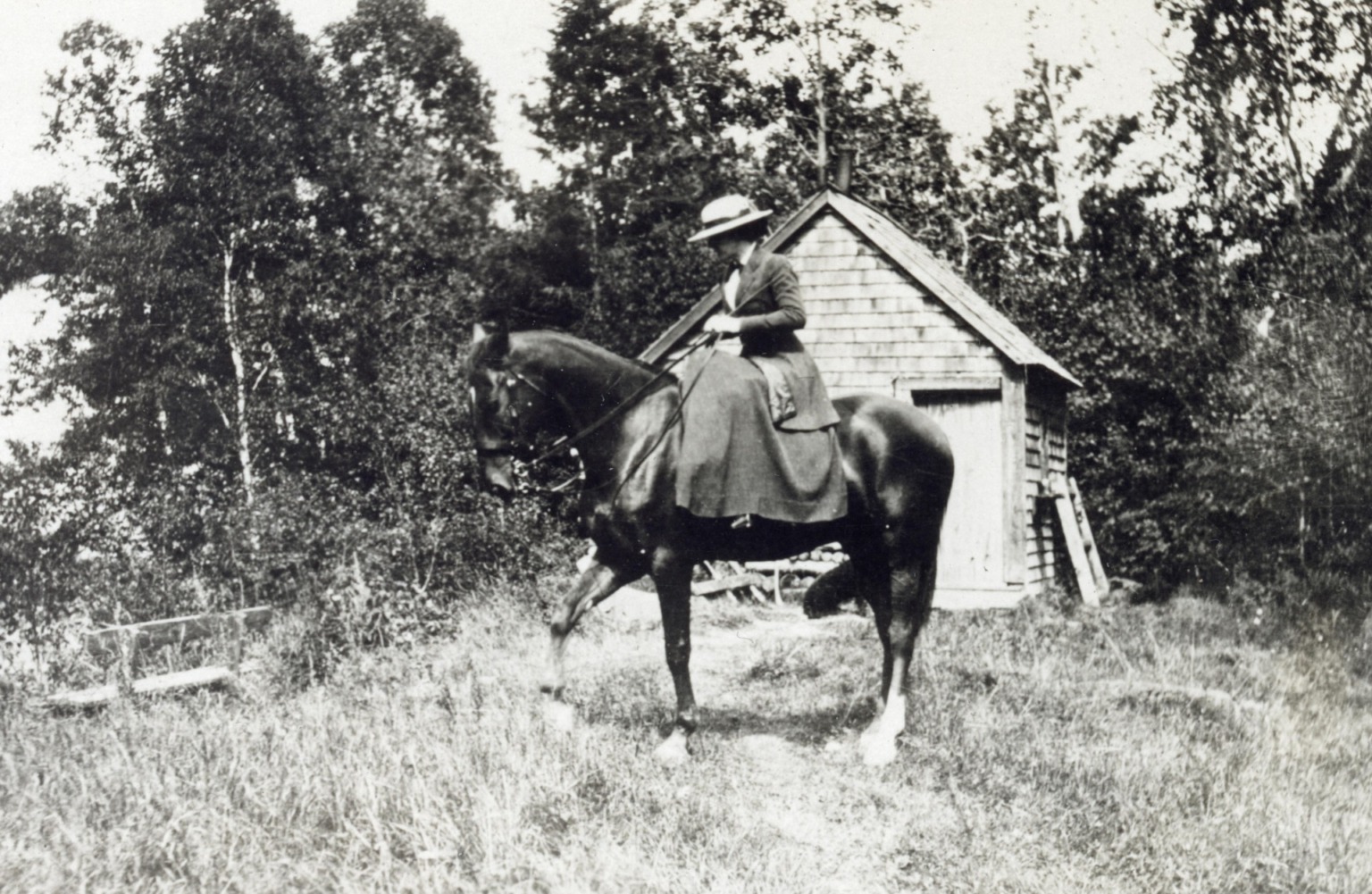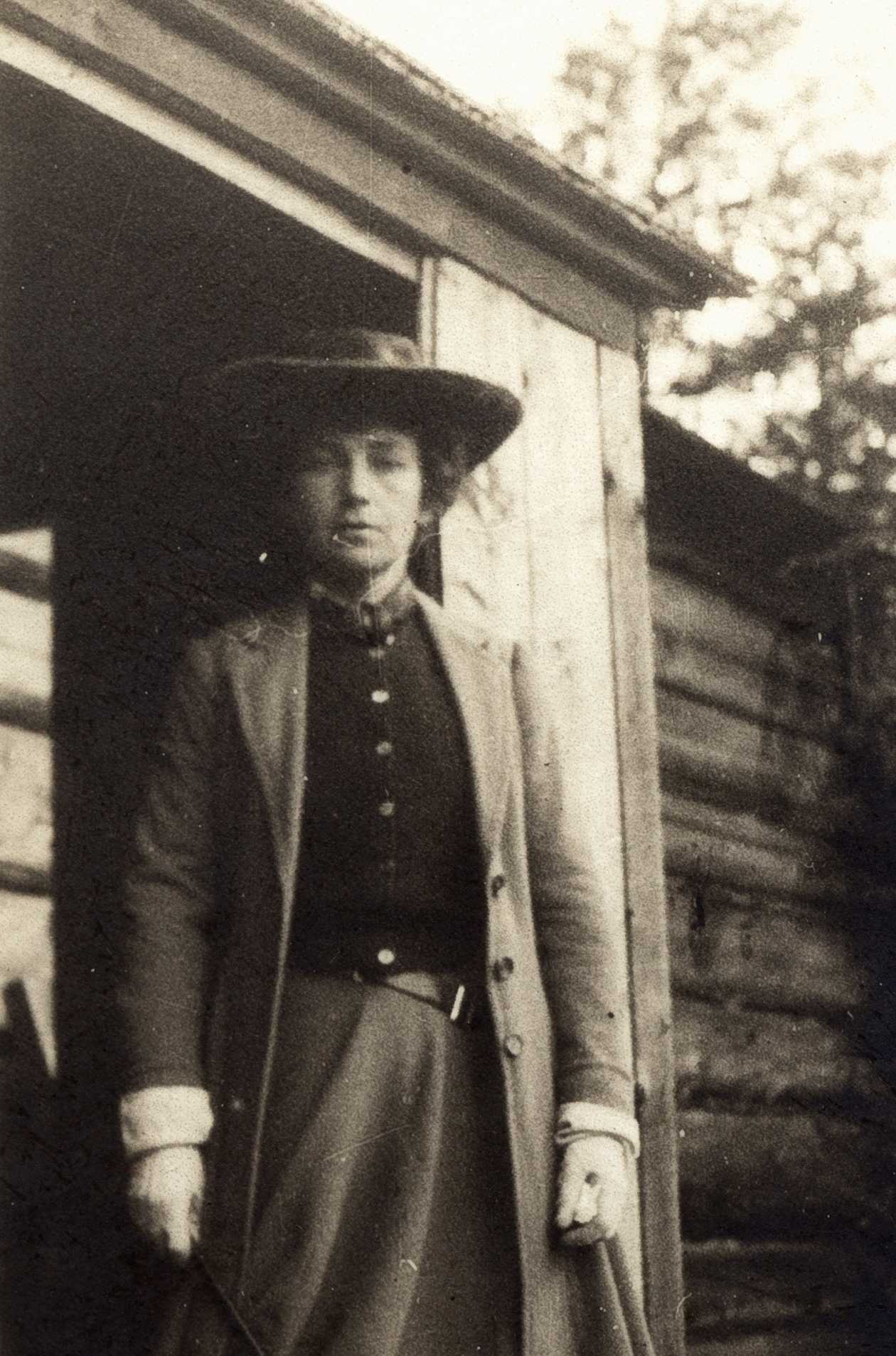
The Elegant Adventurer Elsie Refords Ride from Gaspé 1910
Elsie Reford was an adventurer, of sorts. Her life in Metis was in and of itself an adventure. Getting there required a long train ride and weeks of preparation – but once there, life in her uncle’s large fishing camp was the lap of luxury compared to even the best-equipped cottages and summer homes nearby.
Alexander Reford
Great grand son of Elsie Reford, historian and director, Reford Gardens

In contrast to most of the women of her milieu, summers in Metis were not spent socializing, attending church services, organizing bazaars or enjoying leisurely picnics. She did some of that, but remained mostly aloof from the busy social life that was part of the charm and hurly-burly of summers in Little Metis. Her pursuits were primarily outdoors – riding the rangs on her horse, canoeing in the St. Lawrence below Estevan Lodge and fishing the pools of the Metis River. In the fall she returned with her husband. Gun in hand, she shot partridge and, once, a moose. This exploit was remarked upon. Philippe Hébert, sculptor of the bronze heroes and heroines of Quebec, chose to depict Elsie Reford ‘a l’affût’, on the hunt, a striking bronze statuette of a woman better known for her perfect manners and exquisite apparel than as a gun-toting huntress.
In the summer of 1910, Elsie Reford embarked on what would be her greatest adventure – traversing the Gaspé Peninsula in a canoe and on horseback. A few documents and a handful of photographs illustrate this episode in the life of this exceptional woman.
Her adventure does not figure in her daily diary because she left it behind: “Did not write in this during Gaspé expedition – one of the most enjoyable outings I have ever had. From June 6th to July 3rd”.1 If her diary is mute about the trip itself, we can reconstruct the story from a handful of letters written to her mentor, Governor General Lord Grey, before and after the expedition.
From them, we learn that her trip was not a “coup de tête”: it was the result of several months of planning. The first step was to acquire a horse. An avid rider, Elsie’s horse had been put down the previous year. So began the search for a new one. “My man got me a horse”2 was her triumphal announcement to Lord Grey in May, 1910. Not just any horse, but the winner of the first prize and the Governor General’s cup at the Ottawa Horse Show (he had taken second prize at the Toronto Horse Show a week earlier). The regal gelding “Rodney” won the prize in the saddle horse category, for horses 15 hands 2 inches and taller. The “dark chestnut with beautiful paces”3 came from the London, Ontario, stable of the Hon. Adam Beck, provincial member of parliament and founder of the Ontario Hydro-Electric Commission. Rodney would prove to be the ideal mount for Elsie, although she barely had time to ride him before embarking on her long ride. The quality of the horse was key – particularly as she was to ride side-saddle on uneven and sometimes steep terrain.
She had intended to go alone, but was able to convince a friend, Edith ‘Daisy’ Campbell, to be her companion. A lifelong friend, Campbell was a trained nurse. She would go on to become the most decorated Canadian nurse during the First World War, founding matron of the Duchess of Connaught Canadian Red Cross Hospital at Cliveden, twice mentioned in despatches and one of just nine women to be awarded the Military Medal for her bravery. Just two in the travelling party, their entourage consisted of twelve men and six canoes, along with their cargo of tents and provisions for the month-long voyage.
What had led Elsie Reford to embark on such a journey? Approaching 40 years of age, she had travelled a great deal, but mostly to and from Europe and invariably in the comfort of first-class steamship cabins and hotels. In April, she was among those in attendance at a lecture in the Montreal Arena by Antarctic explorer Ernest Shackleton, who spoke to a large audience about his expedition to attempt to reach the South Pole. Was it Shackleton who inspired her to this adventure? Doubtful, as she found his talk “very slim”. Was it her need to explore new regions of her country or test her own capacity for endurance?
Elsie and Daisy travelled by boat from Montreal to Gaspé. From there, they began the first phase of their expedition, ascending the York River in a canoe. This is the account of the trip in her own words:

“Yesterday I returned from a month of a life which I loved and lived every minute of… My plan for going up the York river, crossing overhand to the St. John and coming back to Gaspé by it, I carried out though when I arrived at Gaspé what had seemed from studying maps, comparatively easy had many difficulties in the way. Only one old hunter knew the trail or rather thought he could find it, which led from one river to the other at the shortest distance across. He had not, nor had any one else, been through for 25 years. I divided my 12 men and 6 canoes into two parties. My friend and I with 3 canoes went up the York while the other 6 men took the remaining 3 canoes up the St. John and left them on it for us to go down in and came through the woods led by the old trapper to take our 3 canoes back down the York. When we got to the appointed place for meeting no one was there however they came out 24 hours late and only a quarter of a mile higher up then they expected. We went within 5 miles of the Lake which is the source of the York. It is a very hard river to pole, one continuous rapid with some extremely difficult places to get over and one moment my canoe was more than half full of water and the excitement was intense. Everywhere we had the most beautiful woods to pitch our tents in and perfect days. Never before in Canada have I heard such singing birds. Their hour began about 4 a.m. and by 5 I was out with them. It is then I think that one feels most nature reaching out her hands to us and though it all be a state of mystic vagueness anything that bears one’s mind so far away cannot surely be vain.”4
“The crossing over to the St John was very hard work, two almost perpendicular mountains to climb but had such lovely wildlowers. Going down the St. John was glorious. For four miles of the north branch it dashed wildly downwards about 15 to 20 yards in width with turnings and twistings and high precipices magnificently wooded. The upper parts of both these rivers have never been cut so it is the forest primeval and the different shades of green from the very tender pale birch hardly out to the dark black spruce lend a wonderful beauty to the finely formed mountains. The water of the St. John is quite as clear as the Cascapedia but while the latter is aquamarine in hue the St. John is positively emerald in parts. Alas almost the entire river is in the hands of an American Club and for a paltry sum to the Quebec Govt. On my way down one of the members most kindly insisted that I should fish one of his pools. I only cast for half an hour and landed 2 fine salmon 18 and 29. They did not play as well as the Metis fish. While I was in Gaspé for a few days I fished one of the lowest pools of the St. John and made a record, 9 fish out of one pool in one afternoon. On the whole trip we had very little wind those wonderful silences at night when « the soul’s fine ear seems to listen and hear », were not the least of all that it was given to me to enjoy.”5

Having ascended the York and descended the St. John, the second leg of the journey began on horseback to ride from Gaspé to Matapedia:
“Rodney I can assure you is worthy of your cup. We did our 200 miles from Gaspé to Matapedia together in nine days without a draw back or a hitch of any kind. He is a perfect delight and has much more sense than any horse I have ever had. He is timid and gentle and a great deal of heart. I enjoyed every moment of my hours in the saddle. The country I went through was lovely and in no part of the world have I ever seen anything finer than the views coming through the Perce Mountains. With the inhabitants all along our journey I had experiences many and varied…”6
Her trip to the Gaspé instilled great pride in her country. “What a wealth of beauty I have seen, what treasures and material riches and what fine people and all this in a comparatively small area of one Province of the Dominion! Do you wonder that I have come back feeling thrilled with pride in my country”.7 Elsie Reford was inspired by Lord Grey to affirm her Canadian nationalism. Politics is what would animate the next decade of her life, where she took an active role in the debate over conscription during the First World War and actively campaigned for the Conservative Party, led by her cousin Arthur Meighen. Her spirit of adventure lived on. She repeated the same expedition several years later with Rodney and her two sons, Bruce and Eric, who joined her on horseback for the ride of their lives.

Elsie Reford 1872-1967
The Reford Gardens (Jardins de Métis) is celebrating the 150th anniversary of the birth of Elsie Reford in 2022. Born in Perth, Ontario on January 23, 1872, Mary Elsie Stephen Meighen was the second child of Robert Meighen and Elsie Stephen. Her mother, Elsie, was the sister of George Stephen. The Meighens moved to Montreal in 1882, where Robert Meighen was given a position in one of Stephen’s flourishing businesses. Young Elsie was educated in Montreal and was then sent to Europe for finishing school. She returned fluent in both French and German. She married Robert W. Reford of Montreal in 1894. They had two sons, Bruce and Eric. An energetic volunteer, from 1904 she became an active ally of Governor General Lord Grey in his many projects, notably the 1908 celebrations of the Tercentenary of Quebec. She founded the Women’s Canadian Club of Montreal with Julia Drummond the same year. Best-known for her gardens, she began the transformation of the fields and forests adjacent to Estevan Lodge in Grand-Métis in 1925. She died in Montreal in 1967, several months shy of turning 96.
Notes
- Elsie Reford diary, 1910.
- Elsie Reford to Lord Grey, May 4, 1910.
- Buffalo Courier, May 8, 1910.
- (4-7)Elsie Reford to Lord Grey, 4 July, 1910.
Photos (in order)
- Estevan Lodge, 1940.
Photo: Robert W. Reford
Les Amis des Jardins de Métis - Elsie Reford, 1911.
Photo: Robert W. Reford
Les Amis des Jardins de Métis - Camping trip on the Métis or Pabos River.
Bibliothèque et Archives Canada